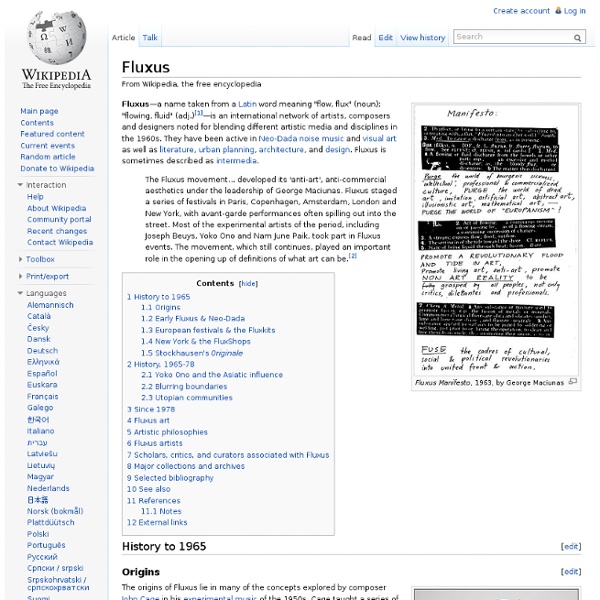Daniel Spoerri
Daniel Spoerri with snare-picture. Early life[edit] Spoerri was born Daniel Isaac Feinstein, on 27 March 1930, in Galați, Romania. Although his father, Isaac Feinstein, had converted to Christianity, after Romania entered the War on the side of Nazi Germany he was arrested and killed in 1941. His mother, born Lydia Spoerri, was Swiss and was therefore able to emigrate with her family of 6 children to Switzerland in 1942. In the 1950s he was active in dance, studying classical dance with Olga Preobrajenska and in 1954 becoming the lead dancer at the State Opera of Bern, Switzerland. Editions MAT[edit] In 1959 Spoerri founded Editions MAT ("Multiplication d'art Transformable"), a venture which produced and sold copies of three-dimensional constructed artworks by artists such as Marcel Duchamp, Dieter Roth, Jean Tinguely and Victor Vasarely. Snare-Pictures (Tableau Pièges)[edit] In 1960, Spoerri made his first "snare-picture". An Anecdoted Topography of Chance[edit] New Realism[edit]
UbuWeb
Google
Fluxus Movement, Artists and Major Works | The Art Story
"In Fluxus there has never been any attempt to agree on aims or methods; individuals with something unnamable in common have simply naturally coalesced to publish and perform their work. Perhaps this common thing is a feeling that the bounds of art are much wider than they have conventionally seemed, or that art and certain long established bounds are no longer very useful." Synopsis Fluxus was a loosely organized group of artists that spanned the globe, but had an especially strong presence in New York City. George Maciunas is historically considered the primary founder and organizer of the movement, who described Fluxus as, "a fusion of Spike Jones, gags, games, Vaudeville, Cage and Duchamp." Key Ideas Unlike previous artistic movements, Fluxus sought to change the history of the world, not just the history of art. Fluxus art involved the viewer, relying on the element of chance to shape the ultimate outcome of the piece. Most Important Art Beginnings Concepts and Styles Fluxus and Zen
Yves Klein
Yves Klein (French: [iv klɛ̃]; 28 April 1928 – 6 June 1962) was a French artist considered an important figure in post-war European art. He is the leading member of the French artistic movement of Nouveau réalisme founded in 1960 by art critic Pierre Restany. Klein was a pioneer in the development of Performance art, and is seen as an inspiration to and as a forerunner of Minimal art, as well as Pop art. Biography[edit] Klein was born in Nice, in the Alpes-Maritimes department of France. From 1942 to 1946, Yves Klein studied at the École Nationale de la Marine Marchande and the École Nationale des Langues Orientales and began practicing judo. With this famous symbolic gesture of signing the sky, Klein had foreseen, as in a reverie, the thrust of his art from that time onwards—a quest to reach the far side of the infinite.[1] Artwork[edit] Monochrome works: The Blue Epoch[edit] Yves Klein, IKB 191, 1962. The Void[edit] Anthropométries[edit] Aero works[edit] Multiples[edit] Last years[edit]
Bidoun Magazine
Elevator to the Gallows (1958
Noise music
Tellus13 Noise music is a term used to describe varieties of avant-garde music and sound art that may use elements such as cacophony, dissonance, atonality, noise, indeterminacy, and repetition in their realization. Noise music can feature distortion, various types of acoustically or electronically generated noise, randomly produced electronic signals, and non-traditional musical instruments. Noise music may also incorporate manipulated recordings, static, hiss and hum, feedback, live machine sounds, custom noise software, circuit bent instruments, and non-musical vocal elements that push noise towards the ecstatic.[1] The Futurist art movement was important for the development of the noise aesthetic, as was the Dada art movement, and later the Surrealist and Fluxus art movements, specifically the Fluxus artists Joe Jones and Takehisa Kosugi.[2] During the early 1900s a number of art music practitioners began exploring atonality.



